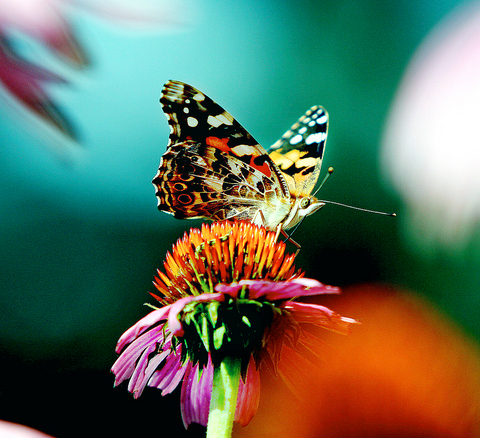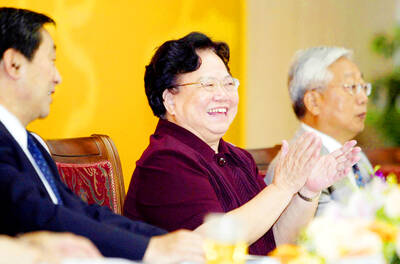British scientists have unveiled plans to create a digital library of all life on Earth. They say that the Digital Automated Identification System (Daisy), which harnesses the latest advances in artificial intelligence and computer vision, will have an enormous impact on research into biodiversity and evolution.
Daisy will also give amateur naturalists unprecedented access to the world's taxonomic expertise: Send Daisy a camera-phone picture of a plant or animal and, within seconds, you will get detailed information about what you are looking at.
At the Natural History Museum in London, Norman MacLeod, keeper of palaeontology, has spent several years developing the new technology.

PHOTO: AP
He said that Daisy will make the identification of plants and animals more objective and directly comparable. "Right now, taxonomy is as much of an art form as it is a science,'' MacLeod said. He would present his vision for Daisy to an international meeting of taxonomists at the museum yesterday.
Taxonomists normally identify specimens through a painstaking process in which the features of an unknown plant or animal are compared with identified specimens in the museum's collections. If it is sufficiently different, the unknown specimen is confirmed as a new species.
However, there is plenty of room for error -- the museum's collection might be incomplete or the person making the identification could make a mistake.
If scientists did not have to make routine identifications and teach others how to do it, MacLeod argues, they could get on with the business of learning more about biodiversity and evolution.
"Say you saw a butterfly, you might take a digital image of it, connect up to the World Wide Web and access a Daisy Internet portal," MacLeod said. "The portal would accept the picture and farm it out to the servers in individual institutions, such as the Natural History Museum."
Using pattern-recognition software, Daisy would try to match the picture with images in its archives. "The portal would route the answer back as a Web page that had the confidence level of the identification and the institution that made the identification,'' MacLeod said.
Daisy can also identify sounds and scans of DNA barcodes.
"New developments in artificial intelligence and computer algorithms have taken neural nets to where they act more like human intelligence," he said. "When we see something new, we don't have to re-compute our understanding of everything else we've ever seen, we just add it to the mix. That's pretty much what we're doing with Daisy."
"Now there's a tool that we can use to justify making the investment in getting these collections of images together and building the software structures that are necessary to make the neural net able to access the images, then there's a reason to do it," he said.
There is also a role for amateur naturalists in improving the library. "One of the neat things about Daisy is that, if you submit an image and it's identified with a high level of certainty, that can then be added to the library of images, which makes Daisy more powerful," MacLeod said.
"That information can keep growing," he said.
"The more people that use [the system], the better it gets," he said.
He said that the first images and sounds have already been used to test that everything works. But filling Daisy with data from all the museums will take several years. The Natural History Museum has 70 million specimens that would need to be entered into the database.
Daisy is part of a series of projects set up by the museum to identify and catalogue life on Earth.
In February, the museum announced plans to record the genetic fingerprints for the species, to begin the process of providing a kind of biometric identity card for millions of species by 2010.

Shamans in Peru on Monday gathered for an annual New Year’s ritual where they made predictions for the year to come, including illness for US President Donald Trump and the downfall of Venezuelan President Nicolas Maduro. “The United States should prepare itself because Donald Trump will fall seriously ill,” Juan de Dios Garcia proclaimed as he gathered with other shamans on a beach in southern Lima, dressed in traditional Andean ponchos and headdresses, and sprinkling flowers on the sand. The shamans carried large posters of world leaders, over which they crossed swords and burned incense, some of which they stomped on. In this

The death of a former head of China’s one-child policy has been met not by tributes, but by castigation of the abandoned policy on social media this week. State media praised Peng Peiyun (彭珮雲), former head of China’s National Family Planning Commission from 1988 to 1998, as “an outstanding leader” in her work related to women and children. The reaction on Chinese social media to Peng’s death in Beijing on Sunday, just shy of her 96th birthday, was less positive. “Those children who were lost, naked, are waiting for you over there” in the afterlife, one person posted on China’s Sina Weibo platform. China’s

‘NO COUNTRY BUMPKIN’: The judge rejected arguments that former prime minister Najib Razak was an unwitting victim, saying Najib took steps to protect his position Imprisoned former Malaysian prime minister Najib Razak was yesterday convicted, following a corruption trial tied to multibillion-dollar looting of the 1Malaysia Development Berhad (1MDB) state investment fund. The nation’s high court found Najib, 72, guilty on four counts of abuse of power and 21 charges of money laundering related to more than US$700 million channeled into his personal bank accounts from the 1MDB fund. Najib denied any wrongdoing, and maintained the funds were a political donation from Saudi Arabia and that he had been misled by rogue financiers led by businessman Low Taek Jho. Low, thought to be the scandal’s mastermind, remains

Australian Prime Minister Anthony Albanese yesterday announced plans for a national bravery award to recognize civilians and first responders who confronted “the worst of evil” during an anti-Semitic terror attack that left 15 dead and has cast a heavy shadow over the nation’s holiday season. Albanese said he plans to establish a special honors system for those who placed themselves in harm’s way to help during the attack on a beachside Hanukkah celebration, like Ahmed al-Ahmed, a Syrian-Australian Muslim who disarmed one of the assailants before being wounded himself. Sajid Akram, who was killed by police during the Dec. 14 attack, and